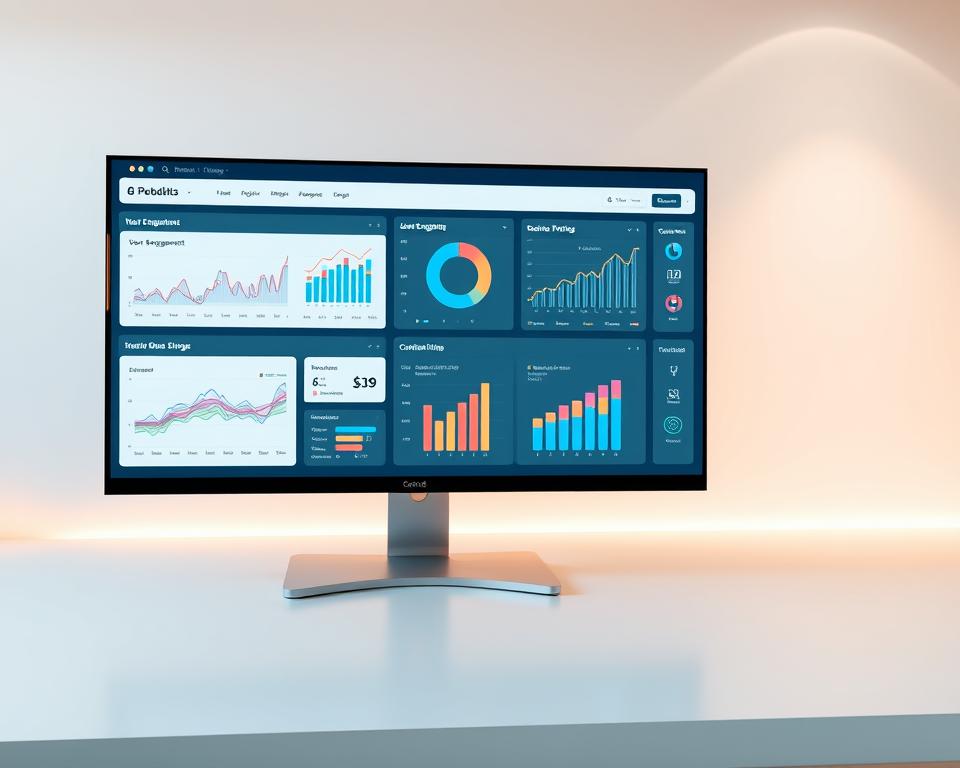Anúncios
Want to know how you can improve business analytics without getting lost in numbers?
Start small and think clearly: by 2025 the digital world will create staggering amounts of data, so you need practical ways to turn that flood into useful decisions.
We’ll preview four lenses—descriptive, diagnostic, predictive, and prescriptive—that help you move from reports to action.
You’ll see why basic skills like SQL and Python or R pair with clear visualization and communication to get results. Real examples, such as Spotify’s Wrapped and Netflix’s content bets, show how insights shape products and experience.
Expect a test-and-learn path: run small pilots, measure outcomes, and scale what works. Add governance and ethical guardrails as you expand, and keep judgment and cross-team collaboration at the center.
Anúncios
This intro sets up practical steps you can start now to translate data into decisions while respecting context, limits, and people.
Introduction: improve business analytics to turn data into decisions
Your organization sits on vast pools of data — the challenge is turning that raw information into useful decisions. The digital world grew to 44 zettabytes by 2020 and is on pace to create massive daily volumes by 2025. That scale makes it urgent to organize data so your teams can act on clear signals, not noise.
Use four practical lenses — descriptive, diagnostic, predictive, and prescriptive — to shape analysis so insights map to real outcomes. Start with simple queries in SQL, add Python or R when you need modeling, and focus on visuals that let stakeholders quickly grasp patterns.
Anúncios
- Act now: market trends and shifting customer behavior mean you should prioritize areas with measurable impact, such as operations and marketing.
- Mindset matters: data-driven leaders welcome testing and evidence; data-informed leaders blend numbers with judgment.
- Start small: run safe pilots, combine customer touchpoints, market signals, and internal metrics, and add governance for privacy and compliance.
Later sections will show concrete ways to apply these lenses across HR, risk, product, and decision governance. For this quarter, pick one area where data already exists and build a lightweight measurement plan. Small progress builds confidence and practical insights you can scale.
Proven ways to improve business analytics in your company
Apply four focused lenses to move from raw reports to clear, testable actions across your teams.
Four lenses and practical questions
Descriptive: what happened? Start with simple KPIs and charts that show trends and totals.
Diagnostic: why did it happen? Segment users, channels, and steps to find root causes.
Predictive: what’s likely next? Use baselines, then add time-series or classification models as data grows.
Prescriptive: what should we try? Lay out options, trade-offs, and risks before acting.
Build the right skills and toolset
Begin with SQL and spreadsheets to clean records, join tables, and produce reproducible KPIs. Then add Python or R for pipelines, testing, and simple models.
Make visualization a habit: align charts to decisions, annotate anomalies, and keep views uncluttered so nontechnical partners can act.
“The four analytic types help teams move from insight to action.”
- Balance data mining with hypothesis-driven tests to avoid chasing noise.
- Use version control and light code review so development stays collaborative and repeatable.
- Set quarterly skill goals; deepen a few tools rather than chasing every new library.
Streamline operations, engagement, and risk with data insights
Turn routine records into clear signals. Start by mapping the processes that matter: throughput, cycle time, and error rates. Use descriptive analytics to set baselines and diagnostic analytics to find why a step stalls.
- Measure process KPIs by step, then run small root-cause checks to isolate drivers.
- Build an operational scorecard with baselines and re-measure after each change.
- Automate pipelines to pull records into clean models and shared dashboards to cut manual reporting.
Enhance productivity with integrated HR analytics
Link your HRMS to operational data to reveal retention, onboarding, and performance patterns. Use leading indicators—like completion rates or voluntary turnover risk—to design targeted, ethical interventions.
Embed risk and cybersecurity detection
Centralize logs and events so you can apply rules and anomaly detection. Configure real-time alerts for suspicious behavior and tune thresholds to limit false positives and alert fatigue.
Standardize pipelines and governance
Document software, dashboards, and metrics so teams keep momentum when staff change. Partner with leaders to align tools and actions to clear objectives—reduce rework, speed first responses, or lower error rates.
- Treat each solution as a test: start small, measure performance, adapt.
- Prioritize solutions that reduce manual work and scale automation where it proves value.
- Balance alerts and thresholds so risk efforts remain focused on high-impact areas.
Use customer, market, and product data to lift experiences and growth
Turn signals from customers and the market into concrete tests that boost engagement and product traction. Start by unifying records across transactions, support, and interactions so profiles stay privacy-conscious and consistent.

Unify customer data sources to personalize CX across channels
Link internal interactions, purchase history, and third‑party feeds to build a single view. Keep consent and clear retention rules.
Use that view to segment users by patterns and to time offers without overpersonalizing.
Measure and improve marketing performance with KPIs and A/B testing
Define clear KPIs: CAC, CTR, conversion rate, and retention. Run controlled A/B campaigns and measure lift with adequate samples.
Track market trends to inform product roadmaps and portfolio focus
Monitor competitor moves and usage signals to spot overlap and differentiation opportunities. Let usage patterns guide sunsetting low-value features and doubling down on sticky experiences.
Real examples and practical steps
- Use data mining cautiously; validate signals with experiments or qualitative feedback.
- Learn from Spotify’s Wrapped: package opt‑in user data into shareable moments to amplify campaigns.
- Learn from Netflix: predictive analysis of viewing signals helps recommend content and shape content bets.
For more on turning customer signals into action, see customer insights and analytics.
Make better decisions with governance, analytics literacy, and leadership
Good governance and clear metrics turn data into timely actions your teams can trust.
Start by defining decision-ready metrics with owners and simple definitions. Give each metric a steward so changes pass a short review. Add guardrails for privacy, access, and appropriate use of information.
Define decision-ready metrics, guardrails, and data governance
Document the source of truth for key measures. Keep a lightweight workflow for metric changes and data access. This keeps products and campaigns aligned and reduces disputes.
Lead with data-driven practices and small-scale tests
Encourage leaders to frame hypotheses and run small tests. Use clear success thresholds and decide in advance how to act. Pair predictive analytics with impact checks and a note of assumptions.
- Build literacy with short trainings and office hours so teams use tools and interpret results.
- Share concise, annotated dashboards that call out trends and outliers.
- Treat solutions as iterative: implement, measure performance, gather feedback, refine or roll back.
“Data-driven leaders let evidence test hypotheses and guide next steps.”
Conclusion
Wrap up with a focus on practical tests, clear measurement, and steady learning.
Use small pilots in priority areas so you can gather quick signals without overcommitting resources. Instrument basic metrics, note assumptions, and pick the right tools or software for the job.
Turn the raw data you collect into actionable insights. Share results clearly so users and stakeholders know what changed and why. Keep governance tight and ownership shared across teams.
Run regular reviews of market signals, product usage, and experience metrics. Iterate: refine models and dashboards as evidence grows. Invite cross‑functional partners to co‑own metrics so the company builds durable habits.
Test, measure, learn, and adapt — a steady cadence will help your teams make better decisions over time without promising exact outcomes.


